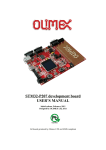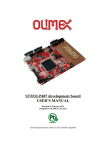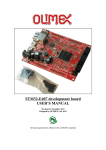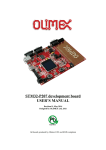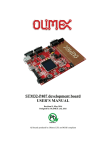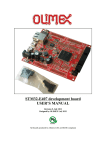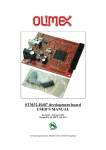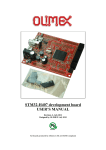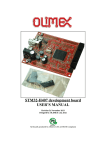Download STM32-P407 development board USER'S MANUAL
Transcript
STM32-P407 development board USER’S MANUAL Initial release, February 2012 Designed by OLIMEX Ltd, 2011 All boards produced by Olimex LTD are ROHS compliant OLIMEX© 2012 STM32-P407 User's Manual Disclaimer: © 2012 Olimex Ltd. Olimex®, logo and combinations thereof, are registered trademarks of Olimex Ltd. Other terms and product names may be trademarks of others. The information in this document is provided in connection with Olimex products. No license, express or implied or otherwise, to any intellectual property right is granted by this document or in connection with the sale of Olimex products. Neither the whole nor any part of the information contained in or the product described in this document may be adapted or reproduced in any material from except with the prior written permission of the copyright holder. The product described in this document is subject to continuous development and improvements. All particulars of the product and its use contained in this document are given by OLIMEX in good faith. However all warranties implied or expressed including but not limited to implied warranties of merchantability or fitness for purpose are excluded. This document is intended only to assist the reader in the use of the product. OLIMEX Ltd. shall not be liable for any loss or damage arising from the use of any information in this document or any error or omission in such information or any incorrect use of the product. Thank you for purchasing STM32-P407 development board assembled by OLIMEX LTD Page 2 of 32 OLIMEX© 2012 STM32-P407 User's Manual Table of Contents CHAPTER 1.................................................................................................................5 OVERVIEW.................................................................................................................5 1. Introduction to the chapter.......................................................................................................5 1.1 Features.....................................................................................................................................5 1.2 Organization.............................................................................................................................6 CHAPTER 2 ................................................................................................................7 SETTING UP THE STM32-P407 BOARD...............................................................7 2. Introduction to the chapter.......................................................................................................7 2.1 Electrostatic warning...............................................................................................................7 2.2 Requirements...........................................................................................................................7 2.3 Powering the board..................................................................................................................8 2.4 Prebuilt software......................................................................................................................8 CHAPTER 3.................................................................................................................9 STM32-P407 BOARD DESCRIPTION.....................................................................9 3. Introduction to the chapter.......................................................................................................9 3.1 Layout (top view).....................................................................................................................9 3.2 Layout (bottom view).............................................................................................................10 CHAPTER 4...............................................................................................................11 THE STM32F407ZGT6 MICROCONTROLLER.................................................11 4. Introduction to the chapter.....................................................................................................11 4.1 The microcontroller...............................................................................................................11 CONTROL CIRCUITY............................................................................................13 5. Introduction to the chapter.....................................................................................................13 5.1 Reset........................................................................................................................................13 5.2 Clock.......................................................................................................................................13 CHAPTER 6...............................................................................................................14 HARDWARE.............................................................................................................14 6. Introduction to the chapter.....................................................................................................14 6.1 JTAG connector.....................................................................................................................14 6.2 UEXT......................................................................................................................................15 6.3 Pads on the proto area...........................................................................................................16 6.4 USB_OTG...............................................................................................................................17 6.5 USB HOST..............................................................................................................................18 6.6 LAN connector.......................................................................................................................18 6.7 PWR Jack...............................................................................................................................19 Page 3 of 32 OLIMEX© 2012 STM32-P407 User's Manual 6.8 Headphones connector..........................................................................................................19 6.9 SD/MMC slot..........................................................................................................................19 6.10 RS232_1................................................................................................................................20 6.11 RS232_2................................................................................................................................20 6.12 CAN connector.....................................................................................................................21 6.13 Battery connector.................................................................................................................22 6.14 Jumper description..............................................................................................................22 6.15 LCD Display with backlight................................................................................................25 6.16 VGA Color Camera.............................................................................................................25 6.17 Additional hardware components......................................................................................26 CHAPTER 7...............................................................................................................27 MEMORY..................................................................................................................27 7. Introduction to the chapter.....................................................................................................27 7.1 Memory map..........................................................................................................................28 CHAPTER 8...............................................................................................................29 SCHEMATICS..........................................................................................................29 8. Introduction to the chapter.....................................................................................................29 8.1 Eagle schematic......................................................................................................................29 8.2 Physical dimensions...............................................................................................................31 CHAPTER 9...............................................................................................................32 REVISION HISTORY..............................................................................................32 9. Introduction to the chapter.....................................................................................................32 9.1 Document revision.................................................................................................................32 9.2 Web page of your device.......................................................................................................32 Page 4 of 32 OLIMEX© 2012 STM32-P407 User's Manual CHAPTER 1 OVERVIEW 1. Introduction to the chapter Thank you for choosing the STM32-P407 development board from Olimex! This document provides a User’s Guide for the Olimex STM32-P407 development board. As an overview, this chapter gives the scope of this document and lists the board’s features. The document’s organization is then detailed. The STM32-P407 development board enables code development of applications running on the M4 CORTEX STM32F407ZGT6 microcontroller, manufactured by STMicroelectronics. 1.1 Features • STM32F407ZGT6 Cortex-M4 210DMIPS, 1MB Flash, 196KB RAM, 3×12-bit 2.4 MSPS A/D, 2×12-bit D/A converters, USB OTG HS and USB OTG HS, Ethernet, 14 timers, 3 SPI, 3 I2C, Ethernet, 2 CANs, 3 12 bit ADCs, 2 12 bit DACs, 114 GPIOs, Camera interface JTAG connector with ARM 2x10 pin layout for programming/debugging • • 512 KB fast external SRAM on board 4 Status LEDs • • Stereo Audio Codec CS4344 CAN driver • • Temperature sensor Trimmer potentiometer • • Joystick for navigation 6610 LCD color 128x128 pixel TFT display • • SAMSUNG E700 VGA camera 640x480 color Tamper and Wakeup buttons • • 2 RS232 drivers and connectors 25 Mhz quartz crystal • • USB_OTG USB_HOST • • 100 Mbit Ethernet Mini SD/MMC card connector • Page 5 of 32 OLIMEX© 2012 STM32-P407 User's Manual • • UEXT connector Power Jack • • RESET button and circuit Power-on led • • 3V battery connector Extension port connectors for many of microcontrollers pins • • PCB: FR-4, 1.5 mm (0,062"), soldermask, silkscreen component print Dimensions: 160x116 mm (6.3x4.6") 1.2 Organization Each section in this document covers a separate topic, organized as follow: – – Chapter 1 is an overview of the board usage and features Chapter 2 provides a guide for quickly setting up the board – – Chapter 3 contains the general board diagram and layout Chapter 4 describes the component that is the heart of the board: the STM32F407ZGT6 microcontroller – – Chapter 5 is an explanation of the control circuitry associated with the microcontroller to reset. Also shows the clocks on the board Chapter 6 covers the connector pinout, peripherals and jumper description – – Chapter 7 shows the memory map Chapter 8 provides the schematics – Chapter 9 contains the revision history Page 6 of 32 OLIMEX© 2012 STM32-P407 User's Manual CHAPTER 2 SETTING UP THE STM32-P407 BOARD 2. Introduction to the chapter This section helps you set up the STM32-P407 development board for the first time. Please consider first the electrostatic warning to avoid damaging the board, then discover the hardware and software required to operate the board. The procedure to power up the board is given, and a description of the default board behavior is detailed. 2.1 Electrostatic warning STM32-P407 is shipped in a protective anti-static package. The board must not be exposed to high electrostatic potentials. A grounding strap or similar protective device should be worn when handling the board. Avoid touching the component pins or any other metallic element. 2.2 Requirements In order to set up the STM32-P407, the following items are required: - 5 Vdc Power supply (or JTAG or SWD, or 5V TRACE, or 5V CAN, or 5V_USB, depending on PWR_SEL jumper position) - SWD interface programmer Note: additionally, the board can be programmed via JTAG interface but there are signals multiplexed with the LCD and the audio, so if using JTAG interface for programming you might need to implement a software mechanism to stop them or you might not be able to reprogram again. You may use a pair of the following devices for this purpose: - Any of Olimex’s ARM-JTAG programmer/debuuger (keeping in mind the note above) - Any of Olimex's ARM-JTAG programmer/debugger + ARM-JTAG-SWD + Rowley CrossWorks Also, a host-based software toolchain is required in order to program/debug the STM32-P407 board. There are also a number of ready IDEs available like IAR Embedded Workbench, Rowley CrossWorks, etc. At the moment of writing this guide our ARM programmers/debuggers equipped with an ARMPage 7 of 32 OLIMEX© 2012 STM32-P407 User's Manual JTAG-SWD work fine (out-of-the-box) with Rowley CrossWorks. 2.3 Powering the board Provide +5 V DC to the board's power jack, OR +5 V via the JTAG or TRACE connector (before providing the power set the PWR_SEL jumper in the correct position) On powering the board the PWR LED, the SATA4 LED and the display should turn on. The SATA1, SATA2 and SATA3 LEDs must start blinking consecutively. If measuring the current consumption it should be around 30 mA. 2.4 Prebuilt software On arrival the board has a basic demo installed which features test of the LEDs, the LCD, the joystick, the camera. IMPORTANT: If you have only a programmer with JTAG interface and you need to turn off the peripherals using the JTAG signals press WKUP button! Pressing WKUP button will turn of those modules and will allow JTAG reprogramming. Page 8 of 32 OLIMEX© 2012 STM32-P407 User's Manual CHAPTER 3 STM32-P407 BOARD DESCRIPTION 3. Introduction to the chapter Here you get acquainted with the main parts of the board. Note the names used on the board differ from the names used to describe them. For the actual names check the STM32-P407 board itself. 3.1 Layout (top view) Page 9 of 32 OLIMEX© 2012 STM32-P407 User's Manual 3.2 Layout (bottom view) Page 10 of 32 OLIMEX© 2012 STM32-P407 User's Manual CHAPTER 4 THE STM32F407ZGT6 MICROCONTROLLER 4. Introduction to the chapter In this chapter is located the information about the heart of STM32-P407 – its microcontroller. The information is a modified version of the datasheet provided by its manufacturers. 4.1 The microcontroller •Core: ARM 32-bit Cortex™-M4 CPU with FPU, Adaptive real-time accelerator (ART Accelerator™) allowing 0-wait state execution from Flash memory, frequency up to 168 MHz, memory protection unit, 210 DMIPS/1.25 DMIPS/MHz (Dhrystone 2.1), and DSP instructions •Memories •1 Mbyte of Flash memory •192+4 Kbytes of SRAM including 64-Kbyte of CCM (core coupled memory) data RAM •Flexible static memory controller supporting Compact Flash, SRAM, PSRAM, NOR and NAND memories •LCD parallel interface, 8080/6800 modes •Clock, reset and supply management •1.8 V to 3.6 V application supply and I/Os •POR, PDR, PVD and BOR •4-to-26 MHz crystal oscillator •Internal 16 MHz factory-trimmed RC (1% accuracy) •32 kHz oscillator for RTC with calibration •Internal 32 kHz RC with calibration •Sleep, Stop and Standby modes •VBATsupply for RTC, 20×32 bit backup registers + optional 4 KB backup SRAM •3×12-bit, 2.4 MSPS A/D converters: 24 channels and 7.2 MSPS in triple interleaved mode •2×12-bit D/A converters •General-purpose DMA: 16-stream DMA controller with FIFOs and burst support •Up to 17 timers: up to twelve 16-bit and two 32-bit timers up to 168 MHz, each with up to 4 IC/OC/PWM or pulse counter and quadrature (incremental) encoder input •Debug mode •Serial wire debug (SWD) & JTAG interfaces Page 11 of 32 OLIMEX© 2012 STM32-P407 User's Manual •Cortex-M4 Embedded Trace Macrocell™ •Up to 114 I/O ports with interrupt capability •Up to 15 communication interfaces •3 × I2C interfaces (SMBus/PMBus) •4 USARTs/2 UARTs (10.5 Mbit/s, ISO 7816 interface, LIN, IrDA, modem control) •3 SPIs (37.5 Mbits/s), 2 with muxed full-duplex I2S to achieve audio class accuracy via internal audio PLL or external clock •2 × CAN interfaces (2.0B Active) •SDIO interface •Advanced connectivity •USB 2.0 full-speed device/host/OTG controller with on-chip PHY •USB 2.0 high-speed/full-speed device/host/OTG controller with dedicated DMA, on-chip full-speed PHY and ULPI •10/100 Ethernet MAC with dedicated DMA: supports IEEE 1588v2 hardware, MII/RMII •8- to 14-bit parallel camera interface up to 54 Mbytes/s •True random number generator •CRC calculation unit •96-bit unique ID •RTC: subsecond accuracy, hardware calendar For comprehensive information on the microcontroller visit the Microchip’s web page for a datasheet. At the moment of writing the microcontroller datasheet can be found at the following link: http://www.st.com/internet/com/TECHNICAL_RESOURCES/TECHNICAL_LITERATURE/DAT ASHEET/DM00037051.pdf If the Cortex M4 processor listed above seems like an overkill we have the same board offered with Cortex M3 one – STM32F207ZET6. The name of the board is STM32-P207. The table of comparison can be found below: STM32F207ZET6 STM32F407ZGT6 Maximum speed 120Mhz 168Mhz Program memory 512KB 1024KB Ram memory 132KB 192KB Page 12 of 32 OLIMEX© 2012 STM32-P407 User's Manual CHAPTER 5 CONTROL CIRCUITY 5. Introduction to the chapter Here you can find information about reset circuit and quartz crystal locations. 5.1 Reset STM32-P407 reset circuit includes R65 (10 KΩ), R66(560 Ω), C45(100 nF), STM32F407ZGT6 pin 25 (NRST) and a RESET button. The RESET is also connected to the proto area. 5.2 Clock 25 MHz quartz crystal Q1 is connected to pins 23 and 24 of the processor. Real time clock (RTC) Q2 is found at pins 8 and 9 of the processor. Page 13 of 32 OLIMEX© 2012 STM32-P407 User's Manual CHAPTER 6 HARDWARE 6. Introduction to the chapter In this chapter are presented the connectors that can be found on the board all together with their pinout. Proto area is shown. Jumpers functions are described. Notes and info on specific peripherals are presented. Notes regarding the interfaces are given. 6.1 JTAG connector The 20 pin JTAG connector provides the interface for JTAG or/and SWD/TRACE programming/debugging. It is advisable to use SWD/TRACE interface programmers. JTAG/SWD interface Pin # Signal Name Pin # Signal Name 1 +3.3V 11 +3.3 V 2 +3.3V 12 GND 3 TRST/SPI1_MISO 13 TDO/I2S3_CK 4 GND 14 GND 5 PGCTDI/I2S3_WS 15 RST 6 GND 16 GND 7 TMS 17 +5V_J-LINK 8 GND 18 GND 9 TCK 19 +5V_J-LINK 10 GND 20 GND Page 14 of 32 OLIMEX© 2012 STM32-P407 User's Manual TRACE interface Pin # Signal Name Pin # Signal Name 1 +3.3V 11 +5V_TRACE 2 TMS 12 TEMP_ALERT 3 GND 13 +5V_TRACE 4 TCK 14 USB_HS_VBUSON 5 GND 15 GND 6 TDO/I2S3_CK 16 DCMI_D4 7 Not connected 17 GND 8 TDI/I2S3_WS 18 DCMI_D6 9 GND 19 GND 10 RST 20 DCMI_D7 6.2 UEXT STM32-P407 board has UEXT connector and can interface Olimex's UEXT modules. For more information on UEXT please visit: http://www.olimex.com/dev/OTHER/UEXT.pdf Pin # Signal Name 1 +3.3V 2 GND 3 DCMI_D0/USART6_TX 4 USART6_RX Page 15 of 32 OLIMEX© 2012 STM32-P407 User's Manual 5 SOFTWARE SCL 6 SOFTWARE SDA 7 SD_D3/USART3_RX/SPI3_MISO 8 SD_CLK/SPI3_MOSI 9 SD_D2/USART3_TX/SPI3_SCK 10 STAT3/CS_UEXT 6.3 Pads on the proto area For your convenience the pads are named individually near each of them. Please take extra care about the numbering but consider that there might be offset. PAD # Signal Name PAD# Signal Name PA0 BUT WKUP RST RST PA4 DCMI_HSYNC PG0 A10 PA5 SPI1_SCK PG1 A11 PA6 DCMI_PIXCLK PG2 A12 PA8 MCO1 PG3 A13 PA9 OTG_FS_VBUS PG4 A14 PA10 DCMI_D1 PG5 A15 PB0 LCD_BL PG6 RIGHT(JOYSTICK) PB1 BUZ PG9 USART6_RX PB2 CAM_ENB PG10 SOFT_SCL PB5 I2S3_SD PF15 A9 PB9 CAN1_TX PF14 A8 PB10 USB_FS_FAULT PF13 A7 PB12 OTG_HS_ID PF12 A6 PB13 OTG_HS_VBUS PF11 CAM_RST Page 16 of 32 OLIMEX© 2012 STM32-P407 User's Manual PC5 ETH_RMII_RXD1 PF10 ETH_RXER PC13 BUT TAMPER PF9 SSTAT4/CAM_PWR PD6 LCD_CS PF8 STAT3/CS_UEXT PE0 /BLE PF7 STAT2/CAN_CTRL PE1 /BHE PF6 STAT1 PE2 TEMP_ALERT PF5 A5 PE3 USB_HS_VBUSON PF4 A4 PE4 DCMI_D4 PF3 A3 PE5 DCMI_D6 PF2 A2 PE6 DCMI_D7 PF1 A1 PE7 D4 PF0 A0 PE8 D5 PE15 D12 PE9 D6 PE14 D11 PE10 D7 PE13 D10 PE11 D8 PE12 D9 +5V +5V DC VBAT VBAT 6.4 USB_OTG Pin # Signal Name 1 +5V 2 D- 3 D+ 4 OTG_HS_ID 5 GND Page 17 of 32 OLIMEX© 2012 STM32-P407 User's Manual 6.5 USB HOST PIN# SIGNAL NAME 1 +5 V 2 USB_HOST_D- 3 USB_HOST_D+ 4 GND 6.6 LAN connector PIN# SIGNAL NAME 1 TX+ 2 TX- 3 VDD 4 NOT CONNECTED 5 NOT CONNECTED 6 VDD 7 RX+ 8 RX- LED Color Usage Right Green Link status Left Yellow Activity status Page 18 of 32 OLIMEX© 2012 STM32-P407 User's Manual 6.7 PWR Jack Pin # Signal Name 1 Power Input 2 GND 6.8 Headphones connector 6.9 SD/MMC slot Pin # Signal Name 1 DAT2 2 DAT3/CS 3 CMD/DI 4 VDD 5 CLK/SCLK Page 19 of 32 OLIMEX© 2012 STM32-P407 User's Manual 6 VSS 7 DAT0/DO 8 DAT1 6.10 RS232_1 RS232_1 is located on USART6/SPI3 line. Check the jumper configuration. Pin # Signal Name 1 Not Connected 2 T1OUT 3 R1IN 4 Not Connected 5 GND 6 Not Connected 7 CTS 8 RTS 9 Not Connected 6.11 RS232_2 RS232_2 is located on USART3 (processor pins D13 – D14, A17 – A16) Pin # 1 Signal Name Not connected Page 20 of 32 OLIMEX© 2012 STM32-P407 User's Manual 2 T1OUT 3 R1IN 4 Not connected 5 GND 6 Not connected 7 CTS 8 RTS 9 Not connected 6.12 CAN connector Pin# Signal name 1 Not connected 2 CANL 3 VSS 4 Not connected 5 VSS 6 GND 7 CANH 8 Not connected 9 +5V_CAN Page 21 of 32 OLIMEX© 2012 STM32-P407 User's Manual 6.13 Battery connector Pin # Signal Name 1 VBAT 2 GND 6.14 Jumper description Most of the jumper configurations are printed with white print on the PCB for your convenience. PWR_SEL On the setting of this jumper depends the way we power the board. There is a table printed on the board with the positions. You can check the table below also. Position 1-2 is the one at the PWR connector side. PWR_SEL 1-2 +5V_EXT 3-4 +5V_J-LINK 5-6 +5V_CAN 7-8 +5V_USB_OTG 9 - 10 +5V_TRACE Default position is 3-4. Page 22 of 32 OLIMEX© 2012 STM32-P407 User's Manual STAT1_E, STAT2_E, STAT3_E, STAT4_E Those 4 jumpers control whether the LEDs are powered(closed) or not(open). Default state is closed. BOOT0_E Connected to pin 138 (BOOT0/VPP), enables boot if closed. Default state is open. RST_E Controls the RST on the RS232_1. If closed is present. Default state is not present. Default state is open. B1_1/B1_0, B0_1/B0_0 These jumpers should be moved together and control the camera being powered. Default state is B1_0, B0_0 (camera powered). Page 23 of 32 OLIMEX© 2012 STM32-P407 User's Manual 3.3V_MCU_EN When closed enables the power supply on the STM32F207ZET. Default state is closed. TX_BOOT_E If closed separates USART6_TX and PC10. Default state is open. RX_BOOT_E If closed separates USART6_RX and PC11. Default state is open. 3.3V_E Board's digital power supply is disabled if open. Enabled if closed. Default state is open. AGND_E Page 24 of 32 OLIMEX© 2012 STM32-P407 User's Manual Analog GND is disabled if open. If closed Analog GND is enabled. Default state is closed. R-T RST and TRST are separated if open. RST and TRST are connected if closed. Refer to the schematic near the JTAG connector for how this jumper influences the JTAG programming of the board. Default state is open. CAN_T Can termination is disabled if open. Default state is open. 6.15 LCD Display with backlight replica of Nokia 6610 color display 128x128 pixels 6.16 VGA Color Camera 640x480 pixels (0.3 mega pixel) Samsung 700 camera + connector Page 25 of 32 OLIMEX© 2012 STM32-P407 User's Manual 6.17 Additional hardware components The components below are mounted on STM32-P407 but are not discussed above. They are listed here for completeness: Joystick Temperature sensor Audio out Trimmer Buzzer Additional memory 2 buttons + RST button 4 status LEDs + PWR LED Page 26 of 32 OLIMEX© 2012 STM32-P407 User's Manual CHAPTER 7 MEMORY 7. Introduction to the chapter On the next page you can find a memory map for this family of processors. It is strongly recommended to refer to the original datasheet released by STMicroelectronics for one of higher quality. Page 27 of 32 OLIMEX© 2012 STM32-P407 User's Manual 7.1 Memory map Page 28 of 32 OLIMEX© 2012 STM32-P407 User's Manual CHAPTER 8 SCHEMATICS 8. Introduction to the chapter In this chapter are located the schematics describing logically and physically STM32-P407. 8.1 Eagle schematic STM32-P407 schematic is visible for reference here. You can also find them on the web page for STM32-P407 at our site: http://www.olimex.com/dev/stm32-P407.html. They are located in HARDWARE section. The EAGLE schematic is situated on the next page for quicker reference. Page 29 of 32 OLIMEX© 2012 STM32-P407 User's Manual Page 30 of 32 OLIMEX© 2012 STM32-P407 User's Manual 8.2 Physical dimensions Note that all dimensions are in inches. Page 31 of 32 OLIMEX© 2012 STM32-P407 User's Manual CHAPTER 9 REVISION HISTORY 9. Introduction to the chapter In this chapter you will find the current and the previous version of the document you are reading. Also the web-page for your device is listed. Be sure to check it after a purchase for the latest available updates and examples. 9.1 Document revision Revision Changes Modified Pages A Initial Creation All 9.2 Web page of your device The web page you can visit for more info on your device is http://www.olimex.com/dev/stm32P407.html. There you can find more info and some examples. ORDER CODES: STM32-P407 - completely assembled and tested ARM-USB-TINY - for custom programming/debugging ARM-USB-TINY-H - for custom programming/debugging USB-MINI-CABLE - USBmini to USB-A cable ARM-JTAG-SWD – SWD adapter for our ARM-JTAG programmers How to order? You can order to us directly or by any of our distributors. Check our webpage http://www.olimex.com/ for more info. Page 32 of 32
































